|
|
|
|
|
|
|
Achi-Kochi Japan
Showing many places to visit and foods to eat in Japan
|
|
|
|
|
|
|
|
|
|
|
|
|
Japan
> Kinki region
> Hiei-zan Enryaku-ji Temple and Sakamoto Towb
|
|
|
|
|
|
|
Hiei-zan Enryaku-ji Temple and Sakamoto Town
Otsu City, Shiga Pref., Kinki ( Achi-Kochi Japan )
|
|
|
|
|
|
|
|
|
|
|
|
|
( "Achi-Kochi" in Japanese means "Here and there" in English. )
Hiei-zan Enryaku-ji Temple and Sakamoto Town
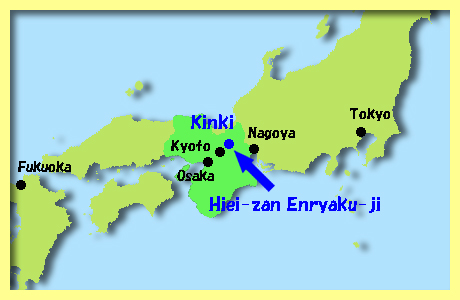
Hiei-zan Enryaku-ji Temple ( above ) is located on Hiei-zan ( Mount Hiei - elevation 848m), which is a part of the border of two prefectures - Kyoto and Shiga. Many tourists visit the temple, which has been and is one of the most famous and important temples in Japan as well as Koya-san Kongobu-ji Temple is.
Hiei-zan Enryaku-ji Temple is a part of the UNESCO World Heritage Site " Historic Monuments of Ancient Kyoto ". There in the site of the temple are several dozens of buildings including National Treasures and Important Cultural Properties of Japan.
Sakamoto Cablecar service connects the temple and Sakamoto town ( Otsu City, Shiga Prefecture ) which is located at the eastern foot of Hiei-zan. Also there are direct bus services to the temple from Kyoto Station and Keihan Sanjo Station. Both stations are located in Kyoto City, Kyoto Prefecture.
|
|
Konpon-chudo ( Main Hall )
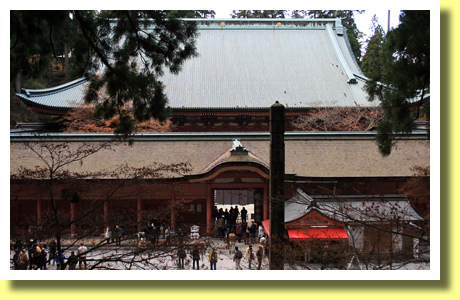
Hiei-zan Enryaku-ji Temple was founded in A.D.788 on Hiei-zan ( Mount Hiei ) by Saicho ( Dengyo Daishi ). Konpon-chudo ( the Main Hall of the temple - above ) stands on the site where Saicho constructed the hall of the temple in the 8th century.
While Saicho, the founder of Tendai School of Japanese Buddhism, was one of the most important and famous Buddhist monks, Hiei-zan Enryaku-ji Temple, the hub of the Tendai School, became so influential not only spiritually but also politically and militarilly. It consisted of a few thousands sub-temples which housed dozens of thousands of monks including warrior monks. The temple hired mercenary troops.
In the 16th century, the temple gave support to the enemies of Nobunaga Oda, the most powerful warlord at the time who was on his way to reunify Japan. So he attacked Hiei-zan Enryaku-ji Temple in A.D.1571. Lots of monks were killed and most of structures were burnt down.
After Nobunaga Oda was killed in A.D.1582, the reconstruction of Hiei-zan Enryaku-ji Temple started. Konpon-chudo was rebuilt in A.D.1642 by Iemitsu Tokugawa, the third shogun of Tokugawa Shogunate. Konpon-chudo is one of National Treasures of Japan. ( Konpon-chudo is under renovation work through A.D.2016 - 2025, though tourists could enter the building. )
|
|
Monju-ro Gate

Monju-ro is the main gate of Konpon-chudo. The 1st Monju-ro was built in A.D.868 and was burnt down by Nobunaga Oda. The 2nd Monju-ro Gate, rebuilt by Iemitsu Tokugawa, was burnt down in A.D.1668. Soon the 3rd gate was reconstructed, which is now one of the important cultural properties of Japan.
|
|
Kaidan-in ( Ordination Hall )

For a dozen of centuries, many monks have been and are trained and ordained in Hiei-zan Enryaku-ji Temple, where the 1st ordination hall was constructed in A.D.828. Now tourists could see Ordination Hall ( above ) which was reconstructed in A.D.1678. The hall is one of Important Cultural Properties of Japan.
|
|
Dai-kodo ( Great Lecture Hall )
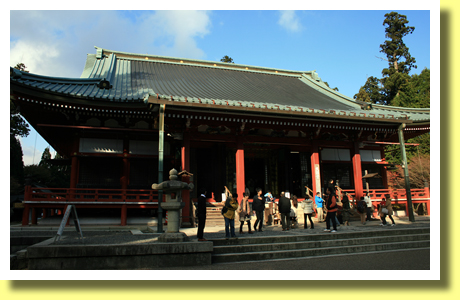
Dai-kodo ( Great Lecture Hall - above ) was built in A.D.1634 in Sakamoto town at the eastern foot of Hiei-zan and was relocated to the present site in A.D.1964. Dai-kodo is now one of Important Cultural Properties of Japan.
Dai-kodo houses statues of Honen, Shinran, Dogen, Eisai, Nichiren and some more. All of them were monks who studied Tendai School of Japanese Buddhism in Hiei-zan Enryaku-ji Temple and founded of their own sects of Japanese Budhism such as Jodo-shu ( Pure Land School ), Jodo Shin-shu ( True Pure Land School ), Soto-shu ( Soto School of Zen ), Rinzai-shu ( Rinzai School of Zen ), Nichiren-shu ( Nichiren School ) and some more.
|
|
Sakamoto Cablecar Service
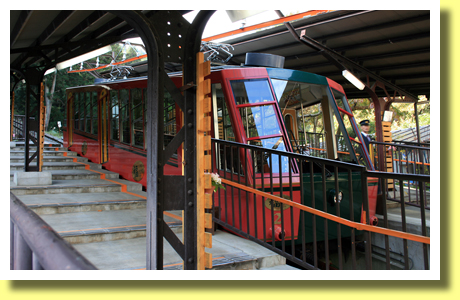
Sakamoto Cablecar Service ( above ) could help tourists move from Hiei-zan Enryaku-ji Temple to Sakamoto Town, which is located at the eastern foot of Hiei-zan. There in the town are shrines and temples which had been and are related to Hiei-zan Enryaku-ji, including dozens of National Treasures and Important Cultural Properties of Japan.
|
|
Shiga-in Monzeki Temple
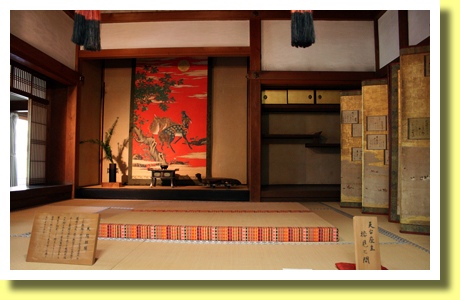
Shiga-in Monzeki is a temple located in Sakamoto Town, Otsu City, Shiga Prefecture. For a few centuries, Shiga-in Monzeki Temple had been a residence for the Head Monk of Tendai School. The above shows a audience room where the visitors were received by the Head Monk in Shiga-in Monzeki Temple.
In the temple, visitors could see various kinds of artifacts related to Hiei-zan Enryaku-ji Temple and the Head Monk of Tendai School. Also its garden is so popular among tourists.
|
|
Former Chikurinin

There had been dozens of satobo in Sakamoto Town. Satobo used to be facilities for monks of Hiei-zan Enryaku-ji Temple to reside after their retirement. Former Chikurin-in was one of satobo and its garden ( above ), one of National Sites of Scenic Beauty. Visitors could enjoy viewing and walking around the garden. Also green tea and traditional Japanese confectionery could be served in a tea house.
|
|
Hiyoshi Taisha Shrine

In Sakamoto Town, many tourists visit Hiyoshi Taisha Shrine, which consists of many structures including National Treasures and National Important Cultural Properties of Japan such as the Main Gate ( above ) of Nishi Hongu ( West Main Shrine ).
|
|
Higashi Hongu ( East Main Shrine )

Higashi Hongu ( East Main Shrine - above ) is one of National Treasures of Japan which tourists could see in Hiyoshi Taisha Shrine as well as Nishi Hongu ( West Main Shrine ) is another one. Higashi Hongu was reconstructed in A.D.1595 after burnt down in A.D.1571 by Nobunaga Oda. Nishi Hongu was reconstructed in A.D.1586.
Hiyoshi Taisha is a Shinto shrine founded several hundred years before Hiei-zan Enryaku-ji, a Buddhist temple, was founded in A.D.788. However the synthesis of Shintoism and Buddhism made Hiyoshi Taisha Shrine subsumed by Hiei-zan Enryaku-ji Temple. The separation of Shintoism and Buddhism was carried out in the 19th century in Meiji Period.
|
|
Mikoshi ( Portable Shrine )
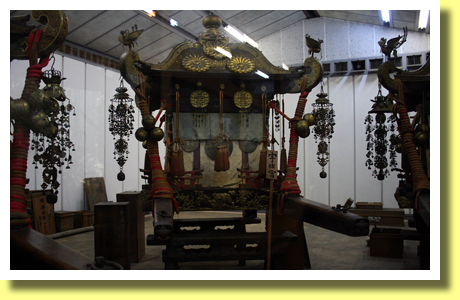
Visitors could see Mikoshi ( Portable Shrines - above ) in Hiyoshi Taisha Shrine. Through the 10th - 16th century, warrior monks of Hiei-zan Enryaku-ji Temple carried Mikoshi from Hiyoshi Taisha Shrine to Kyoto to urge the Court to meet their demands.
Such action helped Hiei-zan Enryaku-ji Temple influential politically until warrior monks were killed in A.D.1571 by Nobunaga Oda. There in Hiyoshi Taisha Shrine are seven Mikoshi Portable Shrines reconstructed in the 16th century, which are Important Cultural Properties of Japan.
|
|
Jigen-do Mausoleum
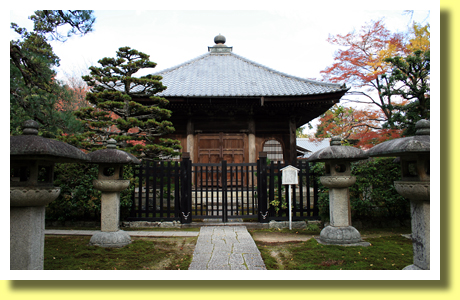
Jigen-do is the mausoleum of Jigen Daishi ( Tenkai ) built in A.D.1643 in Sakamoto Town. It is one of Important Cultural Properties of Japan. Jigen Daishi was a Buddhist monk who had been the advisor of the first three shoguns of Tokugawa Shogunate. He played an important part in the reconstruction of Hiei-zan Enryaku-ji Temple after the destruction in A.D.1571. Also he founded Kan'ei-ji Temple in Ueno in A.D.1625.
|
|
Tsuruki Soba Restaurant
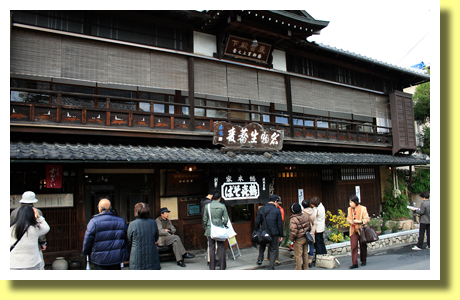
Tsuruki Soba is a soba noodle restaurant founded in A.D.1716 in Sakamoto Town by a monk who had worked in a kitchen of Hiei-zan Enryaku-ji Temple. Since then on, the restaurant had been one of purveyors to the temple. In addition, many of visitors to Hiei-zan Enryaku-ji Temple and/or Hiyoshi Taisha Shrine have lunch in the restaurant, whose building was constructed in the 19th century. It is one of National Registered Tangible Cultural Assets.
|
Copyright (c) 2022 Achi-Kochi Zanmai Co., Ltd.
|